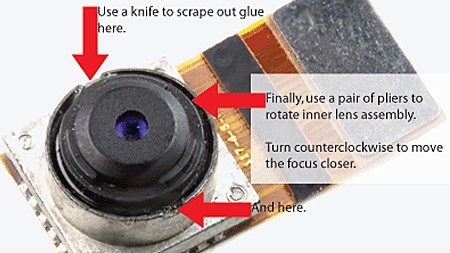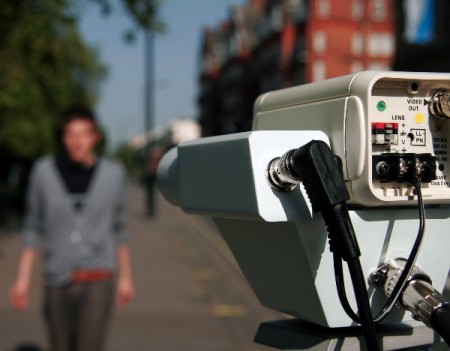
Reader [Adrian] picked up a couple cheap wireless flash triggers on eBay. Unfortunately, his Sigma EF-500 DG Super strobe doesn’t have the necessary sync port to make use of these. He popped the device open to try to figure out a way to trigger the device manually. The first idea was to use the test button to fire the device. Thanks to lag, it didn’t work for anything under 1/20th. The solution was to go straight for the optical trigger. [Adrian] has posted some teardown pictures that will help you determine the appropriate solder points for your own mod. The only bit that’s left is adding a 3.5mm mono headphone jack as a sync port. He also has a post on modifying the flash for greater head movement.
digital cameras hacks981 Articles
Canon 40D Hacked To Record Movies
[youtube=http://www.youtube.com/watch?v=OlKywUVFJW4]
Both Canon and Nikon recently released DSLR cameras that now include a feature that most consumer level digital cameras have had for sometime: the ability to record movies. What makes movie recording especially appealing on a DSLR is the wide selection of lenses available to get the look you’re after. If you’re an owner of Canon’s 40D you may want to follow [DataGhost]’s progress on the CHDK forum as he is currently working on bringing this function to the 40D.
While [DataGhost] has a working proof of concept he notes that there are still some issues pertaining to the camera powering down while recording a video, autofocusing, and writing to the memory card. Aside from this, [DataGhost] has made considerable progress and is considering adding custom user settings via the mode dial to really give some creative control. We’re excited about this hack and can’t wait for its release to the general public.
[via CHDK forum]
Control Your Camera Remotely With A DS

Using a custom built cable connected to the lower GBA slot and a copy of Canon’s SDK, [Steve Chapman] has come up with a very clever way of taking pictures remotely with a Nintendo DS Lite.
Currently the software supports bracket shooting as well as bulb mode. [Steve] points out that he is currently testing an audio based trigger system using the mic built into the DS and the software is still a work in progress.
While the weight saving benefits of using a DS instead of a notebook are obvious, there are things you do give up going this route. Traditionally, when you tether a camera to a computer the photos are saved directly to the computer where you can view the image on a much larger monitor. With the DS, it seems all you can do is remotely trigger the camera. Given the size and resolution of the screens maybe that’s all it can do.
[via Boing Boing Gadgets]
Flickr Photo Bike

Lifehacker’s [Gina Trapani] has one of Flickr’s photo bikes and wrote up how it works. As you ride, the bike automatically takes photographs, geotags them, and uploads them to Flickr. The handlebar unit contains a Nokia N95 cellphone. The rear is a solar powered charging unit. It has a custom python script that starts the photo taking sequence when it detects the bike is in motion using the phone’s accelerometer.
Most of the engineering seems to be for usability’s sake. We’re guessing they probably wanted to disguise that they’re bolting a $600 cellphone to a bike as well. Out of the box the Nokia N95 already does almost everything required. It has a 5 megapixel camera with an interval timer that can vary from 10 seconds to 30 minutes. It supports Flickr uploading, but with software like ShoZu you can streamline the geotagging and make all uploads automatic. Just build a solid mount for your N95 and you’ve pretty much got it, and when you park your bike you can take the phone with you.
Macro Photography With An IPhone

The camera lens on the iPhone is much like any other cameraphone lens in the fact that the lens has a fixed minimum and maximum focus length. If you want to get a little closer to your subject, you just might want to give [eastrain’s] macro camera mod a try.
According to [eastrain] both first and second generation iPhone cameras have a screw type focus ring that has been glued to infinity from the factory. This was probably set so that 99% of your photos were roughly in focus.
Gaining access to the camera lens requires the disassembly of your phone and will undoubtedly void any type of warranty you may have had. Once the lens is in view you will need to break the 2 glue points that hold the lens at its current position.
Using needle nose pliers you can then rotate the lens counter clockwise to increase the zoom or clockwise to decrease it. Enabling the built in camera app allows you to see in real time your changes. When you’re satisfied, just put everything back together. Of course the next step should be an externally mounted ring to allow manual zooming on the fly.
Wiimoteless IR Whiteboard

[Eduard] sent in his IR webcam whiteboard project. He wanted something like the Wiimote version, but without the expense of a Wiimote. He added some film negative to the camera to reduce the amount of visible light picked up by the CCD. (He notes that you might need to pull the IR filter from your camera to get a decent signal.) The pen is the usual IR LED with a power supply. To do the actual work, he wrote a custom application in Java.
Surveillance As Art

The Target Project is a graduate project from the Royal College of Arts in London. It is designed to make us question our relationship with surveillance technology and CCTV. This is a particularly meaningful demonstration for a country like Britain which is said to contain up to 4.2 million CCTV cameras or roughly 1 for every 14 people.
This project has two demonstrations on their site. The first is dubbed the RTS-2 (Racial Targeting System). This system is essentially a camera which follows faces and is able to analyze and interpret the person’s race. The second is SOLA. This system is able to quickly scan someone and calculate their body mass index then publish this information to the web. Both systems achieve their goal by blatantly pointing out a line in which more surveillance does not equate to more security. They also show the wealth of personal data that can be obtained about a person by a simple camera.
[via we make money not art]










